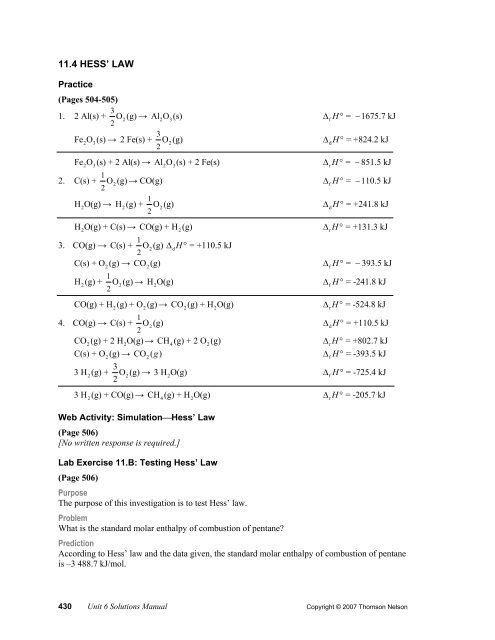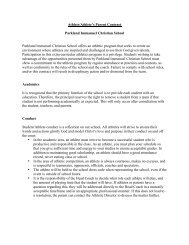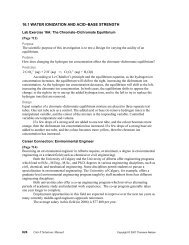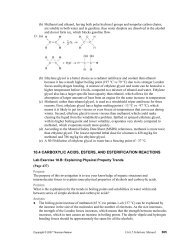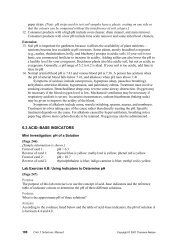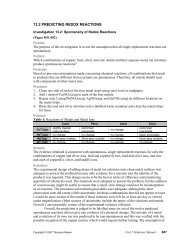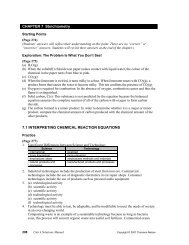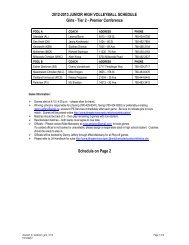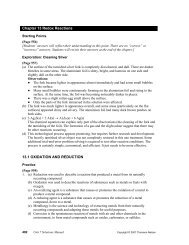11.4 HESS' LAW
11.4 HESS' LAW
11.4 HESS' LAW
You also want an ePaper? Increase the reach of your titles
YUMPU automatically turns print PDFs into web optimized ePapers that Google loves.
<strong>11.4</strong> HESS’ <strong>LAW</strong><br />
Practice<br />
(Pages 504-505)<br />
3<br />
1. 2 Al(s) + O<br />
2<br />
(g) Al 2<br />
O 3<br />
(s) f H = 1675.7 kJ<br />
2<br />
3<br />
Fe2O 3(s) 2 Fe(s) + O<br />
2<br />
(g) d H<br />
= +824.2 kJ<br />
2<br />
Fe2O 3(s) + 2 Al(s) Al 2<br />
O 3<br />
(s) + 2 Fe(s) r H = 851.5 kJ<br />
1<br />
2. C(s) + O<br />
2(g) CO(g) f H = 110.5 kJ<br />
2<br />
1<br />
HO(g)<br />
2<br />
H(g) 2<br />
+ O(g) 2<br />
d H<br />
= +241.8 kJ<br />
2<br />
H2O(g) + C(s) CO(g) + H<br />
2<br />
(g) r H<br />
= +131.3 kJ<br />
1<br />
3. CO(g) C(s) + O<br />
2(g) d H<br />
= +110.5 kJ<br />
C(s) + O<br />
2(g) 2<br />
1<br />
H<br />
2(g) + O<br />
2(g) 2<br />
2<br />
2<br />
CO (g) f H = 393.5 kJ<br />
HO(g) f H<br />
= -241.8 kJ<br />
CO(g) + H<br />
2(g) + O<br />
2(g) CO 2<br />
(g) + H 2<br />
O(g) r H<br />
= -524.8 kJ<br />
1<br />
4. CO(g) C(s) + O<br />
2(g) d H<br />
= +110.5 kJ<br />
2<br />
CO<br />
2(g) + 2 H2O(g) CH 4<br />
(g) + 2 O 2<br />
(g) r H<br />
= +802.7 kJ<br />
C(s) + O<br />
2(g) CO 2<br />
( g)<br />
f H<br />
= -393.5 kJ<br />
3<br />
3 H<br />
2(g) + O<br />
2(g)<br />
3 H 2<br />
O(g) f H<br />
= -725.4 kJ<br />
2<br />
3 H<br />
2(g) + CO(g) CH 4<br />
(g) + H 2<br />
O(g) r H<br />
= -205.7 kJ<br />
Web Activity: SimulationHess’ Law<br />
(Page 506)<br />
[No written response is required.]<br />
Lab Exercise 11.B: Testing Hess’ Law<br />
(Page 506)<br />
Purpose<br />
The purpose of this investigation is to test Hess’ law.<br />
Problem<br />
What is the standard molar enthalpy of combustion of pentane?<br />
Prediction<br />
According to Hess’ law and the data given, the standard molar enthalpy of combustion of pentane<br />
is –3 488.7 kJ/mol.<br />
430 Unit 6 Solutions Manual Copyright © 2007 Thomson Nelson
C 5 H 12 (l) 5 C(s) + 6 H 2 (g) d H<br />
= +173.5 kJ<br />
5 C(s) + 5 O 2 (g) 5 CO 2 (g) f H<br />
= -1 967.5 kJ<br />
6 H 2 (g) + 3 O 2 (g) 6 H 2 O(g) f H<br />
= -1 450.8 kJ<br />
6 H 2 O(g) 6 H 2 O(l) con H<br />
= -243.9 kJ<br />
C 5 H 12 (l) + 8 O 2 (g) 5 CO 2 (g) + 6 H 2 O(l) c H = 3 488.7 kJ<br />
3 488.7 kJ<br />
H = = 3 488.7 kJ/mol<br />
1 mol<br />
c m<br />
CH 5 12<br />
Analysis<br />
Q<br />
mct<br />
1.24 kg <br />
4.19 J<br />
g•°C<br />
(37.6 18.4) °C<br />
= 99.8 kJ<br />
99.8 kJ<br />
cH<br />
m<br />
<br />
CH<br />
1mol<br />
5 12<br />
2.15g <br />
72.17g<br />
3.35MJ/mol<br />
According to the evidence collected in this experiment and the law of conservation of energy, the<br />
molar enthalpy of combustion of pentane is reported as –3.35 MJ/mol.<br />
Evaluation<br />
The experimental design is adequate. Calorimetry is an obvious way to test a prediction from<br />
Hess’ law. The major uncertainties related to the design are due to measurement uncertainties and<br />
the difference in conditions for obtaining the predicted and experimental answers. The predicted<br />
value corresponds to standard ambient temperature and pressure (SATP) conditions, whereas the<br />
experimental value does not. However, I feel confident enough in the evidence to use it to test the<br />
prediction.<br />
The percent difference of this experiment is 4.0%, as shown by the following calculation:<br />
3.35 MJ/mol 3.4887 MJ/mol<br />
% difference = 100 = 4.0%<br />
3.4887 MJ/mol<br />
The prediction is judged to be verified. The percent difference is reasonably low and is<br />
likely due to the uncertainties mentioned. Hess’ law appears to be acceptable since the prediction<br />
was verified.<br />
The purpose of this investigation was accomplished for only one example, which is not<br />
sufficient to test Hess’ law. Additional investigations, including a variety of chemical reactions,<br />
are required to better achieve the purpose.<br />
Lab Exercise 11.C: Analysis Using Hess’ Law<br />
(Page 506)<br />
Purpose<br />
The purpose of this exercise is to use Hess’ law to determine an enthalpy change.<br />
Problem<br />
What is the standard enthalpy change for the production of hydrogen from methane and steam?<br />
CH 4 (g) + H 2 O(g) CO(g) + 3 H 2 (g) r H = ?<br />
Copyright © 2007 Thomson Nelson Unit 6 Solutions Manual 431
Analysis<br />
[Many solutions are possible. Two are given below. Encourage students to find other solutions to<br />
emphasize this point when using Hess’ law: the net enthalpy change is independent of the route.]<br />
(from 2) CH 4 (g) + 2 O 2 (g) CO 2 (g) + 2 H 2 O(g) c H = -802.5 kJ<br />
(from 3) CO 2 (g) + H 2 (g) CO(g) + H 2 O(g) r H = +41.2 kJ<br />
(from 4) 4 H 2 O(g) 4 H 2 (g) + 2 O 2 (g) d H<br />
= +967.2 kJ<br />
CH 4 (g) + H 2 O(g) CO(g) + 3 H 2 (g) r H<br />
= +205.9 kJ<br />
According to the evidence from equations 2, 3, and 4 and Hess’ law, the standard enthalpy<br />
change for the production of hydrogen from methane and steam is +205.9 kJ.<br />
1<br />
(from 1) C(s) + O<br />
2(g) CO(g) c H = -110.5 kJ<br />
2<br />
1<br />
(from 4) H 2 O(g) H 2<br />
(g) + O 2<br />
(g) d H<br />
= +241.8 kJ<br />
2<br />
(from 5) CH 4 (g) C(s) + 2 H 2 (g) d H<br />
= +74.6 kJ<br />
CH 4 (g) + H 2 O(g) CO(g) + 3 H 2 (g) r H<br />
= +205.9 kJ<br />
According to the evidence from equations 1, 4, and 5 and Hess’ law, the standard enthalpy<br />
change for the production of hydrogen from methane and steam is +205.9 kJ.<br />
[Other solutions include reactions using equations 5 and 6, equations 2, 7, and 8, equations 1, 5,<br />
7, and 8, equations 2, 4, and 8, and equations 2, 4, and 7.]<br />
Investigation 11.3: Applying Hess’ Law<br />
(Pages 507, 517)<br />
Purpose<br />
The purpose of this investigation is to use Hess’ law to determine a molar enthalpy of<br />
combustion.<br />
Problem<br />
What is the standard molar enthalpy of combustion for magnesium?<br />
Procedure<br />
1. Measure precisely about 1.00 g of magnesium oxide in a clean, dry calorimeter.<br />
2. Obtain 50.0 mL of 1.00 mol/L HCl(aq) in a 50 mL graduated cylinder.<br />
3. Measure the initial temperature of the HCl(aq).<br />
4. Add the acid to the magnesium oxide and quickly cover the calorimeter.<br />
5. Stir and record the maximum temperature of the mixture.<br />
6. Dispose of the contents in the sink, rinse and dry the calorimeter cup.<br />
7. Obtain about 15 cm of magnesium ribbon and clean it with steel wool.<br />
8. Measure the mass of the clean magnesium ribbon.<br />
9. Place 50.0 mL of HCl(aq) into a 50 mL graduated cylinder.<br />
10. Place the acid into the calorimeter and record the initial temperature.<br />
11. Add the magnesium ribbon to the calorimeter, making sure all of the metal is in the acid.<br />
12. Cover and stir; record the maximum temperature.<br />
13. Dispose of the contents in the sink.<br />
432 Unit 6 Solutions Manual Copyright © 2007 Thomson Nelson
Evidence<br />
Reacting MgO(s) and Mg(s) with HCl(aq)<br />
Reactant Mass (g) Initial temperature of<br />
HCl(aq) (°C)<br />
Final temperature of<br />
mixture (°C)<br />
magnesium oxide 0.91 23.6 36.0<br />
magnesium metal 0.16 23.6 37.7<br />
50.0 mL of 1.00 mol/L HCl(aq) were used for each reaction.<br />
Analysis<br />
Q <br />
(calorimeter)<br />
mct<br />
50.0g <br />
4.19J<br />
g•°C<br />
(36.0 23.6) °C<br />
2.60 kJ<br />
2.60 kJ<br />
rH<br />
m<br />
<br />
MgO<br />
1mol<br />
0.91g <br />
40.31g<br />
0.12MJ/mol<br />
According to the evidence, the molar enthalpy of reaction for magnesium oxide is reported as<br />
–0.12 MJ/mol.<br />
Q mct<br />
(calorimeter)<br />
4.19J<br />
50.0g (37.7 23.6) °C<br />
g•°C<br />
2.95 kJ<br />
2.95 kJ<br />
rH<br />
m<br />
<br />
Mg<br />
1mol<br />
0.16g <br />
24.31g<br />
0.45MJ/mol<br />
According to the evidence, the molar enthalpy of reaction for magnesium is reported as<br />
–0.45 MJ/mol.<br />
According to Hess’ law, the three equations can be combined as follows.<br />
MgCl 2 (aq) + H 2 O(l) MgO(s) + 2 HCl(aq)<br />
Mg(s) + 2 HCl(aq) MgCl 2 (aq) + H 2 (g)<br />
1<br />
H<br />
2(g) + O<br />
2(g) H2O(l)<br />
2<br />
r H = 1 mo × +0.12 MJ/mol = +0.12 MJ<br />
r H = 1 mol × (0.45 MJ/mol) = 0.45 MJ<br />
r H = 0.2858 MJ<br />
1<br />
Mg(s) + O<br />
2<br />
(g) MgO(s)<br />
c H = 0.62 MJ<br />
2<br />
0.62 kJ<br />
Therefore, cH<br />
m<br />
= 0.62 MJ/mol<br />
Mg 1mol<br />
According to the evidence collected and Hess’ law, the molar enthalpy of combustion for<br />
magnesium is 0.62 MJ/mol.<br />
Evaluation<br />
[Parts 1, 2 and 3 of the Evaluation should have been checked in the Report Checklist.]<br />
The design using a simple polystyrene calorimeter is judged to be adequate because the<br />
problem was answered with no obvious flaws. A more sophisticated calorimeter could be used as<br />
Copyright © 2007 Thomson Nelson Unit 6 Solutions Manual 433
an alternative. However, the design used in this experiment is simpler and less expensive. The<br />
materials were adequate for the chosen design, although a more accurate balance (e.g., milligram<br />
balance) would improve the overall certainty to three significant digits. The procedure was<br />
adequate, although additional trials would improve the certainty of the answer. The technological<br />
skills were simple and adequate.<br />
Overall, I am moderately certain of the results. Sources of uncertainty include limitations<br />
of the measurements made, heat losses by the calorimeter, and the non-SATP conditions under<br />
which the results were obtained. I would estimate a 5% total for these uncertainties.<br />
The accuracy of the results obtained is reflected by the percent difference shown.<br />
0.62 MJ/mol - 0.6016 MJ/mol<br />
% difference = 100 = 3.0%<br />
0.6016 MJ/mol<br />
The prediction is judged to be verified as supported by the low (3.0%) percent difference.<br />
Hess’ law is judged to be acceptable because the prediction was verified.<br />
The purpose of this investigation has been met. Hess’ law passed a severe test—being<br />
able to predict. Further tests of Hess’ law in other contexts need to be done if the law is to gain<br />
even greater acceptance.<br />
Explore an Issue: Alternative Energy Sources and Technologies<br />
(Pages 507–508)<br />
Issue<br />
What is the most effective use of government funding for research in energy technology?<br />
Resolution<br />
The provincial and federal governments should direct all their research funding to bio-based<br />
energy technology.<br />
Design<br />
Within small groups, research the pros and cons of using public money to fund bio-based versus<br />
fossil-fuel-based energy technology.<br />
Evidence<br />
Pros<br />
Bio-based energy technology:<br />
is cleaner<br />
is renewable<br />
is sustainable<br />
may create more jobs<br />
may improve our quality of life<br />
will likely diversify our economy<br />
will benefit farmers growing grain<br />
will benefit owners of wood lots<br />
may improve our environment<br />
preserves fossil fuels for future generations<br />
Cons<br />
Bio-based energy technology:<br />
would be costly to research and develop<br />
may not make use of readily available energy<br />
resources, including other renewable energy<br />
sources<br />
will likely not fully meet all energy demands<br />
lacks the infrastructure for distribution<br />
will likely produce an expensive bio-fuel<br />
may increase the cost and availability of food<br />
will bring oil and gas companies less money<br />
may mean that oil and gas investors lose<br />
money<br />
Analysis<br />
On the basis of the evidence collected and discussion within the group, there is no clear<br />
consensus for or against the resolution. There was a general agreement that the resolution should<br />
not say “all” and would be better changed to “significant” or “increased”.<br />
Evaluation<br />
The design is adequate, but some improvements could include a voting system within the group,<br />
assigning ratings to distinguish more important from less important perspectives, and collating<br />
the results of several groups.<br />
434 Unit 6 Solutions Manual Copyright © 2007 Thomson Nelson
Section <strong>11.4</strong> Questions<br />
(Pages 508–509)<br />
1. C 6 H 12 O 6 (s) 2 C 2 H 5 OH(l) + 2 CO 2 (g) r H = ?<br />
C 6 H 12 O 6 (s) + 6 O 2 (g) 6 CO 2 (g) + 6 H 2 O(l)<br />
c H = –2 803.1 kJ<br />
4 CO 2 (g) + 6 H 2 O(l) 2 C 2 H 5 OH(l) + 6 O 2 (g) r H = +2 733.6 kJ<br />
net: C 6 H 12 O 6 (s) 2 CO 2 (g) + 2 C 2 H 5 OH(l)<br />
r H = 69.5 kJ<br />
2. (a) C 2 H 6 (g) C 2 H 4 (g) + H 2 (g) r H = ?<br />
C 2 H 6 (g) + 7 2 O 2(g) 2 CO 2 (g) + 3 H 2 O(l)<br />
r H = 1 560.4 kJ<br />
2 CO 2 (g) + 2 H 2 O(l) C 2 H 4 (g) + 3 O 2 (g) r H = +1 411.0 kJ<br />
H 2 O(l) H 2 (g) + 1 2 O 2(g)<br />
r H = +285.8 kJ<br />
net: C 2 H 6 (g) C 2 H 4 (g) + H 2 (g)<br />
r H = +136.4 kJ<br />
(b) C 2 H 4 (g) + H 2 O(l) C 2 H 5 OH(l) r H = ?<br />
C 2 H 4 (g) + 3 O 2 (g) 2 CO 2 (g) + 2 H 2 O(l)<br />
r H = 1 411.0 kJ<br />
2 CO 2 (g) + 3 H 2 O(l) C 2 H 5 OH(l) + 3 O 2 (g) r H = +1366.8 kJ<br />
net: C 2 H 4 (g) + H 2 O(l) C 2 H 5 OH(l)<br />
r H = 44.2 kJ<br />
(c) This technique works because the addition of any chemical equations that yield the<br />
intended net chemical reaction will provide the net enthalpy charge. All of the reaction<br />
paths start and end with the same chemicals and the same chemical potential energy (and<br />
thus the same change in enthalpy).<br />
3. CH 4 (g) + H 2 O(l) CH 3 OH(l) + H 2 (g) r H = ?<br />
CH 4 (g) + H 2 O(l) CO(g) + 3 H 2 (g)<br />
r H = +249.9 kJ<br />
CO(g) + 2 H 2 (g) CH 3 OH(l)<br />
r H = 128.7 kJ<br />
net: CH 4 (g) + H 2 O(l) CH 3 OH(l) + H 2 (g)<br />
r H = +121.2 kJ<br />
121.2 kJ<br />
Therefore, rH<br />
m<br />
= +121.2 kJ/mol<br />
CH 1mol<br />
3OH<br />
4.<br />
Question Fuel (a)<br />
Net synthesis<br />
enthalpy<br />
change (kJ)<br />
(b)<br />
Molar enthalpy<br />
of combustion<br />
(kJ/mol)<br />
(c)<br />
Molar enthalpy<br />
of synthesis<br />
(kJ/mol)<br />
(d)<br />
Net molar<br />
enthalpy<br />
(kJ/mol)<br />
1 ethanol from glucose –1 366.8 69.5 1 436.3<br />
69.5<br />
(exothermic)<br />
2 ethanol from ethane –1 366.8 +92.2 1 274.6<br />
+92.2<br />
(endothermic)<br />
(from 2(a) & (b))<br />
3 methanol from methane<br />
+121.2<br />
(endothermic)<br />
–725.9 +121.2 604.7<br />
(c) In most cases, the production of these fuels is slightly endothermic, whereas the<br />
combustion is always very exothermic. Therefore, on the basis of this information the net<br />
process is very exothermic.<br />
(e) On the basis of this information, producing both bio-fuels makes sense from an energy<br />
perspective. Ethanol from glucose makes the most sense, as it releases the most net<br />
energy per mole.<br />
5. The supply of trees for methanol and grain for ethanol also affects the choice. Other costs<br />
incurred by this process include the harvesting and processing of the original starting<br />
Copyright © 2007 Thomson Nelson Unit 6 Solutions Manual 435
materials, and the production and maintenance of transportation and manufacturing<br />
equipment. Also, the calculations above do not take into account the expense of increasing<br />
the rates of reaction by increasing the temperature of the reaction system.<br />
6. Some technological solutions would include: more fuel-efficient vehicles, better public<br />
transportation systems, more and better recycling technologies, more energy-efficient<br />
housing, and technologies to improve the energy efficiency of industries (especially those<br />
industries that are producing energy-related products).<br />
7. C 2 H 2 (g) + 2 H 2 (g) C 2 H 6 (g) r H = ?<br />
C 2 H 2 (g) + 5 2 O 2(g) 2 CO 2 (g) + H 2 O(l)<br />
r H° = 1299 kJ<br />
2 H 2 (g) + O 2 (g) 2 H 2 O(l) r H° = 572 kJ<br />
2 CO 2 (g) + 3 H 2 O(l) C 2 H 6 (g) + 7 2 O 2(g) r H° = +1560 kJ<br />
net: C 2 H 2 (g) + 2 H 2 (g) C 2 H 6 (g)<br />
r H° = 311 kJ<br />
1mol 311kJ<br />
rH<br />
200g <br />
CH<br />
26.04g 1 mol<br />
2 2<br />
2.39 MJ<br />
1 mol 205.7 kJ<br />
rH<br />
300g <br />
8. CO<br />
28.01g 1 mol<br />
2.20 MJ<br />
9. 8 C(s) + 9 H 2 (g) C 8 H 18 f H =?<br />
8 C(s) + 8 O 2 (g) 8 CO 2 (g) r H = –3148 kJ<br />
9 H 2 (g) + 9 2 O 2(g) 9 H 2 O(g) r H = –2572.2 kJ<br />
8 CO 2 (g) + 9 H 2 O(g) C 8 H 18 (l) + 25 O 2(g) c H = +5470.1 kJ<br />
2<br />
net: 8 C(s) + 9 H 2 (g) C 8 H 18 (l)<br />
f H = 250.1 kJ<br />
10. The reference equations are:<br />
(1) C 2 H 5 OH(l) + 3 O 2 (g) 2 CO 2 (g) + 3 H 2 O(l) 1 H = 1367 kJ<br />
(2) CH 3 COOH(l) + 2 O 2 (g) 2 CO 2 (g) + 2 H 2 O(l) 2 H = 875 kJ<br />
Applying Hess’ Law:<br />
C 2 H 5 OH(l) + 3 O 2 (g) 2 CO 2 (g) + 3 H 2 O(l)<br />
r H = 1367 kJ<br />
2 CO 2 (g) + 2 H 2 O(l) CH 3 COOH(l) + 2 O 2 (g) r H = +875 kJ<br />
net: C 2 H 5 OH(l) + O 2 (g) CH 3 COOH(l) + H 2 O(l)<br />
r H = 492 kJ<br />
11. Purpose<br />
The purpose of this investigation is to use Hess’ law to determine a molar enthalpy of<br />
combustion.<br />
Problem<br />
What is the enthalpy change for the reaction of aqueous potassium hydroxide with aqueous<br />
hydrobromic acid?<br />
Prediction<br />
According to Hess’ law, the enthalpy change of the direct reaction of aqueous potassium<br />
hydroxide and aqueous hydrobromic acid should equal the sum of the enthalpy changes of the<br />
two other reactions that produce the net reaction equation for aqueous potassium hydroxide<br />
and aqueous hydrobromic acid.<br />
The enthalpy change required to answer the problem is the first given equation:<br />
436 Unit 6 Solutions Manual Copyright © 2007 Thomson Nelson
HBr(aq) + KOH(aq) H 2 O(l) + KBr(aq) 1 H = ?<br />
This chemical equation can be obtained by adding the third given equation to the reverse of<br />
the second given equation:<br />
KOH(s) + HBr(aq) H 2 O(l) + KBr(aq) 3 H = ?<br />
KOH(aq) KOH(s) 2 H = ?<br />
Therefore, on the basis of Hess’ law, 1 H = 3 H + ( 2 H).<br />
Analysis<br />
Experiment 1:<br />
HBr(aq) + KOH(aq) H 2 O(l) + KBr(aq) 1 H = ?<br />
Q mct<br />
calorimeter<br />
H<br />
n m<br />
HBr<br />
200.0 g <br />
4.19 J<br />
g• C<br />
(22.5 20.0) C<br />
2.10 kJ<br />
2.10 kJ<br />
<br />
1.00 mol<br />
0.100L <br />
1 L<br />
21.0 kJ/mol<br />
According to the evidence and the reaction of one mole of HBr(aq):<br />
HBr(aq) + KOH(aq) H 2 O(l) + KBr(aq)<br />
1 H = 21.0 kJ<br />
Experiment 2: [in 200 mL of solution]<br />
KOH(s) KOH(aq) 2 H = ?<br />
Q mct<br />
calorimeter<br />
200.0g <br />
4.19J<br />
g•°C<br />
(24.120.0) °C<br />
3.44 kJ<br />
3.44 kJ<br />
rH<br />
m<br />
<br />
KOH<br />
1mol<br />
5.61g <br />
56.11g<br />
34.4 kJ/mol<br />
According to the evidence and the dissolving of one mole of KOH(aq):<br />
KOH(s) KOH(aq)<br />
2 H = 34.4 kJ<br />
Experiment 3:<br />
KOH(s) + HBr(aq) H 2 O(l) + KBr(aq) 3 H = ?<br />
Copyright © 2007 Thomson Nelson Unit 6 Solutions Manual 437
Q<br />
calorimeter<br />
<br />
mct<br />
4.19J<br />
200.0g (26.7 20.0) °C<br />
g•°C<br />
5.61 kJ<br />
5.61 kJ<br />
rH<br />
m<br />
<br />
KOH<br />
1mol<br />
5.61g <br />
56.11g<br />
56.2 kJ/mol<br />
According to the evidence and the reaction of one mole of KOH(s):<br />
KOH(s) + HBr(aq) H 2 O(l) + KBr(aq)<br />
On the basis of the results of the three experiments and Hess’ law,<br />
KOH(s) + HBr(aq) H 2 O(l) + KBr(aq)<br />
KOH(aq) KOH(s)<br />
net: HBr(aq) + KOH(aq) H 2 O(l) + KBr(aq)<br />
3 H = 56.2 kJ<br />
3 H = 56.2 kJ<br />
2 H = (34.4 kJ)<br />
net H = 21.8 kJ<br />
Evaluation<br />
The experimental design is based on Hess’ law, and provides the evidence necessary to<br />
provide an analytical answer against which to test the prediction. The Materials, Procedure<br />
and skills are not provided and/or not witnessed, so they cannot be judged here. On the basis<br />
of the experimental design and the evidence provided, it appears that one can be confident<br />
enough to use this evidence and the Analysis above to judge Hess’ law.<br />
The percent difference between the experimental result of measuring the<br />
neutralization of aqueous potassium hydroxide and aqueous hydrobromic acid directly, and<br />
the experimental results for the same net reaction obtained from calorimetry for two different<br />
reactions and Hess’ law is as follows:<br />
21.8 kJ ( 21.0 kJ)<br />
% difference 100 4%<br />
21.0 kJ<br />
This percent difference is relatively low and clearly within expected experimental<br />
uncertainties. Therefore, the prediction is verified and Hess’ law has passed the test in this<br />
investigation. I am reasonably confident in this judgment.<br />
The purpose of the investigation has been achieved—Hess’ law was tested.<br />
11.5 MOLAR ENTHALPIES OF FORMATION<br />
Lab Exercise 11.D: Testing r H° from Formation Data<br />
(Page 513)<br />
[Only Evaluation Parts 2 and 3 can be completed by students.]<br />
Purpose<br />
The purpose of this problem is to test the use of molar enthalpies of formation as a method of<br />
predicting the enthalpy change of a reaction.<br />
Problem<br />
What is the standard molar enthalpy of combustion of methanol?<br />
438 Unit 6 Solutions Manual Copyright © 2007 Thomson Nelson


